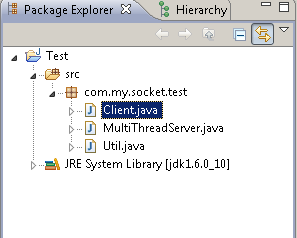参照网上代码:
1.工程:
2.代码:
Client.java
package com.my.socket.test; import java.io.BufferedReader; import java.io.IOException; import java.io.InputStreamReader; import java.io.OutputStream; import java.net.Socket; public class Client { public static final String CHARCODE = "utf-8"; public static void main(String[] args) { Socket socket = null; int port = 8821; OutputStream socketOut = null; BufferedReader br = null; try { socket = new Socket("localhost", port); // 发送消息 String msg = "wwwwwwwwwwww哈哈w1241243123"; // base64 编码,防止中文乱码 msg = Util.encode(msg.getBytes(CHARCODE)); System.out.println("c1:" + msg); System.out.println("c2:" + Util.decode(msg,CHARCODE)); msg = msg + " "; socketOut = socket.getOutputStream(); socketOut.write(msg.getBytes(CHARCODE)); socketOut.flush(); // 接收服务器的反馈 br = new BufferedReader(new InputStreamReader( socket.getInputStream())); String res = br.readLine(); if (res != null) { res = Util.decode(res,CHARCODE); System.out.println("c3:" + res); } } catch (IOException e) { e.printStackTrace(); } finally { try { if (socket != null) socket.close(); } catch (IOException e) { e.printStackTrace(); } try { if (br != null) br.close(); } catch (IOException e) { e.printStackTrace(); } if (socketOut != null) { try { socketOut.close(); } catch (IOException e) { e.printStackTrace(); } } } } }
MultiThreadServer.java
package com.my.socket.test; import java.io.BufferedReader; import java.io.IOException; import java.io.InputStream; import java.io.InputStreamReader; import java.io.OutputStream; import java.io.PrintWriter; import java.net.ServerSocket; import java.net.Socket; import java.util.concurrent.ExecutorService; import java.util.concurrent.Executors; public class MultiThreadServer { private int port = 8821; private ServerSocket serverSocket; private ExecutorService executorService; private final int POOL_SIZE = 10; public MultiThreadServer() throws IOException { serverSocket = new ServerSocket(port); executorService = Executors.newFixedThreadPool(Runtime.getRuntime() .availableProcessors() * POOL_SIZE); System.out.println("服务已启动"); } public void service() { while (true) { Socket socket = null; try { socket = serverSocket.accept(); executorService.execute(new Handler(socket)); } catch (Exception e) { e.printStackTrace(); } } } public static void main(String[] args) throws IOException { new MultiThreadServer().service(); } } class Handler implements Runnable { public static final String CHARCODE = "utf-8"; private Socket socket; public Handler(Socket socket) { this.socket = socket; } private PrintWriter getWriter(Socket socket) throws IOException { OutputStream socketOut = socket.getOutputStream(); return new PrintWriter(socketOut, true); } private BufferedReader getReader(Socket socket) throws IOException { InputStream socketIn = socket.getInputStream(); return new BufferedReader(new InputStreamReader(socketIn)); } public void run() { BufferedReader br = null; PrintWriter out = null; try { br = getReader(socket); out = getWriter(socket); String msg = null; while ((msg = br.readLine()) != null) { System.out.println("s1:" + msg); msg = Util.decode(msg,CHARCODE); System.out.println("s2:" + msg); String res = "wwwwwwwwwwww哈哈w1241243123"; res = Util.encode(res.getBytes(CHARCODE)); System.out.println("s1:" + res); System.out.println("s2:" + Util.decode(res,CHARCODE)); out.println(res); out.flush(); } } catch (IOException e) { e.printStackTrace(); } finally { try { if (socket != null) socket.close(); } catch (IOException e) { e.printStackTrace(); } try { if (br != null) br.close(); } catch (IOException e) { e.printStackTrace(); } if (out != null) { out.close(); } } } }
Util.java
package com.my.socket.test;
import java.io.IOException;
import sun.misc.BASE64Decoder;
import sun.misc.BASE64Encoder;
public class Util {
public static String decode(String str, String charCode) {
try {
return new String(new BASE64Decoder().decodeBuffer(str), charCode);
} catch (IOException e) {
e.printStackTrace();
}
return null;
}
public static String encode(byte[] bstr) {
return new BASE64Encoder().encode(bstr);
}
}